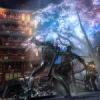“There lived a man who was a legend among mercenaries.
A man who put together a formidable unit of soldiers of fortune, long before the advent of private military companies, that dared to call itself a nation.
A man who, with his nation at his back, made an enemy of modern capitalist society and the world.
This is his story.”
This is the man known as Big Boss, the biggest and bossiest title of manhood for the manliest mercenary ever known to grace the world of video games. And ladies can just call him Snake, if they please.
 But Big Boss doesn’t sound like Big Boss; at least, not the Big Boss that fans all know. David Hayter, who has starred as the voice of Snake and Snake Sr. since the original Metal Gear Solid, is gone. In his stead, Hollywood actor Kiefer Sutherland channels his best Jack Bauer performance from tv show 24.
But Big Boss doesn’t sound like Big Boss; at least, not the Big Boss that fans all know. David Hayter, who has starred as the voice of Snake and Snake Sr. since the original Metal Gear Solid, is gone. In his stead, Hollywood actor Kiefer Sutherland channels his best Jack Bauer performance from tv show 24.
While the change in voice actor certainly takes some getting used to, Sutherland is a good fit for the role; his performance brings just the right amount of gruffness to Big Boss, and he delivers his lines with a believable degree of terseness, befitting a war-hardened veteran.
The game also looks fantastic. Much has been made of Kojima Productions’ proprietary FOX Engine; but seeing it in motion is something else. Fabric flaps in the wind, character animations are almost life-like, while the lighting and weather effects continually impress. There are a few issues with draw distance - and some scenes display the dreaded jaggies - but overall, Ground Zeroes is a phenomenal-looking title. It will be interesting to see the engine being really put through its paces in the upcoming open-world Phantom Pain, rather than the miniature playground on offer here.
Ground Zeroes takes off just a few months after the conclusion of PSP strategy title Peace Walker. It sees our protagonist, Big Boss - aka Snake Sr. - and his growing army, Militaires Sans Frontières, on the hunt for nuclear weapons held by their enemies, with Cipher believed to be at the helm. Matters only get worse when it’s discovered that Chico has been captured and detained at Camp Omega after trying to rescue an until-then-presumed-to-be-dead Paz. Not willing to allow MSF to be compromised, Snake infiltrates Camp Omega with the intent of extracting Paz and Chico, if they’re still alive.
If this means nothing to you, then Ground Zeroes may not be the game for you. While an attempt is made to help newcomers catch up, via a lengthy text-based exposition dump accessed via the menu, for the most part Ground Zeroes is a game that requires extensive knowledge of franchise history if you’re to have any hope of understanding what’s going on. You can still have fun without that knowledge - just don’t expect to understand the significance of any of the game’s events or the lengthy conversations which feature.
Rain and unpleasant news set the stage for the first chapter of the latest Metal Gear Solid entry, which is undoubtedly the most ambitious - if short-winded - game in the series to date. Ground Zeroes plays like the first act to a much larger story that is to be continued in the next installment, Phantom Pain. Even though your time with Ground Zeroes will be brief, the gameplay within is unparalleled and inspired, and far more open than prior series entries.
Kojima Productions is clearly dead-set on bridging together slow, stealth-based mechanics with those of a high-profile action game. Long gone are the days of sitting through monologues via codec; information is now instantly available by looking at something and pressing a button. Snake can now dive, dash and duck with ease, making reaching that bit of cover on the fly all the easier. Sprinting does create more noise, however, so enemies will hone in on your position if you carelessly run around nearby. The same can be said for diving; both maneuvers should be used sparingly, or to evade immediate danger.
Swapping weapons and items is no longer delegated to the shoulder buttons. Using the d-pad allows for nearly immediate weapon and item swaps, with the result that players now have the ability to mix their tactics up in real-time, without going to a screen that freezes the action.
To offset the cost of being spotted and immediately going into a classic MGS alert phase - which could be excruciating lengthy in previous games - Kojima and Co. have incorporated a new feature to the series. Being detected triggers a slow-motion event, whereby Snake is given a chance to incapacitate the enemy that spotted him. If they’re knocked unconscious or eliminated before backup can be called, the alert phase can be avoided altogether.
Aiming weapons is smoother than ever, even when compared to the impressive mechanics in MGS4, and new weapons can be obtained at any point in time. Enemies can be tagged with the binoculars, allowing Snake to see them through walls when they’re close-by (a feature that can be turned off), and they’ll be permanently placed on the new and convenient mini-map.
The game doesn’t stop when the player goes into the map screen, but an app can be downloaded which grants you a permanent second-screen map to look at. Vehicles and weapon-emplacements can be tagged to the map as well, allowing for quick and versatile decision-making. Also, just as in Peace Walker, an army can be made and maintained.
While the campaign mode is short and sweet – it took us roughly four hours to complete our first, check-under-every-stone run-through - and even less on our second run through – there are a wide variety of additional missions, called Side Ops, available. All of these are based within the same area as the campaign, albeit set before the main storyline of Ground Zeroes.
In one, Snake is sent in to either eliminate or extract a Marine Corps sniper team that is hiding out to avoid extradition for war crimes. In another scenario, a MSF spy (aka, Hideo Kojima himself) has infiltrated the camp and is requesting an  emergency evacuation. In that scenario, Snake provides support from the open hatch of a helicopter before having to infiltrate the camp and meet with a new informant. A third scenario has Snake being sent in to disable the base’s anti-air defenses, which is only the setup for an even greater high-caliber ending.
emergency evacuation. In that scenario, Snake provides support from the open hatch of a helicopter before having to infiltrate the camp and meet with a new informant. A third scenario has Snake being sent in to disable the base’s anti-air defenses, which is only the setup for an even greater high-caliber ending.
All of the Side Ops wind up telling a singular tale about Cipher setting up the compound to affront MSF operations, and create additional replay value for players who want to experience the game and utilize different tactics. While the main campaign is short, these additional missions perform an admirable job of padding out the experience. The result is a game that gives out as much as you’re willing to put into the experience, and provides far more content than is initially apparent. You can also now interrogate enemies, rather than simply incapacitate them. Interrogating them might reveal the location of a weapon, backstory details, or perhaps nothing at all. The mechanic adds another layer of depth to the experience, and it’s surprising just how much content is locked away in the tiny slice of gameworld on show.
As the final cut-scenes wind down, it’s clear that while not completely eradicated, MSF will never be the same. In a gruesome interrogation scene, the brutal and relentless villain Skull Face, the leader of the new XOF unit, takes the main stage. He manages to show that he has the potential of being placed among the long list of great villains who flood the series - though we won’t know for sure how low he’s willing to go to kill Snake and Miller until The Phantom Pain drops.
While Ground Zeroes is certainly enjoyable while it lasts, there’s no getting away from the fact that it feels more like a glorified demo than a full-fledged game. While we’re eager to dive into any iteration of MGS, the hefty price tag here won’t be worthwhile to many, particularly those who don’t hold a firm grasp of the series’ extensive backstory. Still, while it lasts, it’s certainly fun – and if you’re a fan of the series, it will leave you wanting more - and there’s plenty of content to be found for those willing to invest plenty of time in uncovering it.
Ground Zeroes is a game that initially looks light on content, but which rewards diligence, exploration and experimentation. We’re not quite sure that it justifies its price tag, but we spent our time having too much fun messing around to really care.





